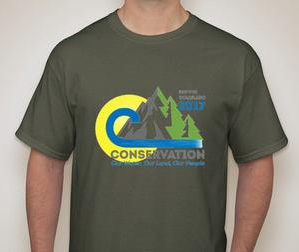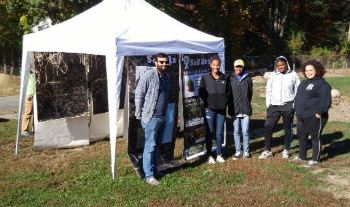NACD’s 2017 Annual Meeting Approaching Quickly
Don’t miss out: early bird registration for Annual Meeting ends this Friday, December 16! Make sure to take advantage of these reduced prices and register today. Annual Meeting guests will stay at the Sheraton Denver Downtown, and rooms are filling up fast!
NACD’s 71st Annual Meeting will include keynote speeches from American Farm Bureau Federation President Zippy Duvall and Colorado Governor John Hickenlooper, as well as panels on the West’s wild horse and burro and water conservation challenges. You’ll want to reserve your seat for the screening of Unbranded, with a special introduction by documentarian Ben Masters, to learn how he and a group of friends trekked over 2,000 miles of the American West on horseback. The annual meeting offers beautiful tours of the sights surrounding Denver, but you’re sure to learn about the unique challenges the state faces as well. During your stay, you’ll want to attend our breakout sessions (check out the descriptions online here), where you’ll have the chance to engage in conversation with experts across the diverse field of conservation.
It’s not too late to become a sponsor for the Annual Meeting, or to donate an auction item! The Live Auction on Monday, January 30, featuring auctioneer Johnny Regula, is quickly shaping up to be better  than ever—check out the list of donated items and start saving up for handpainted mailboxes, use of Case IH tractors, or a John Deere Gator Utility Vehicle! than ever—check out the list of donated items and start saving up for handpainted mailboxes, use of Case IH tractors, or a John Deere Gator Utility Vehicle!
After you complete your early bird registration, make sure to order an Annual Meeting t-shirt and pack a book to donate to North Elementary in Colorado. We look forward to seeing you in Denver in just over a month!
NACD puts out press release, sends letter on BLM planning rule
Last week, NACD sent a letter and put out a press release on the Bureau of Land Management’s final planning rule, commonly referred to as “Planning 2.0,” published in the Federal Register earlier this month. NACD submitted comments on the proposed version of the planning rule in May 2016 and although it recognizes the agency has made improvements to the rule in its final form, it is still concerned the regulation inadequately acknowledges the critical importance of local involvement in the planning process.
“For one, the BLM’s rule would require that all land management plans used in the agency’s planning process be approved by local, state, or tribal governments. As an organization that represents thousands of local entities, we know just how resource-intensive and time consuming developing and approving these plans can be, and fear this provision could disincentivize local participation,” NACD President Lee McDaniel said. “In the past, local governments with policies and programs for public lands management were included in the BLM’s planning process, but now, unless they have an ‘official’ plan, these entities won’t be able to participate at the same level.”
You can learn more about BLM’s Planning 2.0 by heading over to NACD’s Newsroom and by attending our 2017 Annual Meeting in Denver where Kristin Bail, BLM’s assistant director for renewable resources and planning, will be giving a presentation on the regulation at our Public Lands RPG meeting.
Your update from Washington, D.C.
Late last week, the House of Representatives and the Senate passed a continuing resolution to fund the federal government through April 28, 2017 at Fiscal Year (FY) 2016 levels. Now that Congress has passed the funding bill, the 114th Congress is officially closed. When the 115th Congress opens on January 3, 2017, it will have several things on its plate, not the least of which will be funding the federal government through the end of FY 2017 and holding confirmation hearings for President-elect Trump’s numerous Cabinet appointments.
Speaking of appointments, another Cabinet member was announced last week that will be of interest to conservation districts. Current Oklahoma Attorney General Scott Pruitt has been nominated by the president-elect to head the Environmental Protection Agency (EPA). Because Trump has promised to roll back many EPA-led initiatives, NACD and the rest of Washington, D.C., will be watching this appointment closely over the coming months. The USDA secretary and other top USDA officials, such as the chief of NRCS, have not been announced, but speculation abounds. We’re hearing North Dakota Senator Heidi Heitkamp, a Democrat, and former Georgia Governor Sonny Purdue, a Republican, are at the top of Trump’s list.
Mason represents NACD at Ohio River Basin Alliance Summit
 The Ohio River Basin Alliance (ORBA) met in Cincinnati, Ohio, last week to discuss research, public use and access, and current projects in the river basin and brainstorm strategies to engage new partners. NACD North Central Region Representative Beth Mason was in attendance, representing the interests of soil and water conservation districts along the basin. The Ohio River Basin Alliance (ORBA) met in Cincinnati, Ohio, last week to discuss research, public use and access, and current projects in the river basin and brainstorm strategies to engage new partners. NACD North Central Region Representative Beth Mason was in attendance, representing the interests of soil and water conservation districts along the basin.
ORBA is a coalition of industry, governmental, and non-governmental partners. The organization has four working groups – Enterprise and Infrastructure, Restoration and Protection, Sustainable Growth and Competitiveness, and Water Availability and Management – all charged with two goals: (1) identifying high priority challenges in the basin that can be improved through regional collaboration, and (2) identifying organizations for which the challenge is strategic. At this meeting, each group also discussed the America’s Watershed Initiative’s report card for the Ohio-Tennessee Rivers and how that baseline assessment can be improved.
Currently, ORBA is actively searching for regional sponsorship to move the alliance’s efforts forward. For more information on ORBA, its mission and vision, and how to be engaged, please be sure to visit their website.
In summer 2016, NACD teamed up with NRCS to award $2 million in grants to 42 conservation districts in 25 states to boost technical assistance capacity for urban agriculture conservation projects. The Eastern Connecticut Conservation District in Connecticut was one of the initiative’s 2016 awardees.

ECCD’s winning proposal detailed its plans to provide technical assistance to community garden associations in marginalized, predominately minority communities challenged by food deserts. The district’s technical assistance efforts focused on improving soil health, increasing crop productivity, and protecting water quality in these gardens. It also sought to create a community where gardening ideas and conservation resources could be shared.
This fall, ECCD staff worked with GROW Windham to plan a new model community garden. The site was prepared with compost, fencing, garden beds, and a demonstration plot for cover crops. The staff also teamed up with partners to design workshops – the first of which was called “Soil First: Foundations for Successful Gardens and Farms” and drew an audience of 35 in mid-October. As part of the session, Kip Kolesinskas, a retired NRCS soil conservationist representing the University of Connecticut Cooperative Extension, led hands-on activities on the importance and value of soil analysis.
Four additional hands-on workshops will be conducted on water quality, water conservation and irrigation, composting, and integrated pest management, and an urban growers’ conference will be held in March prior to the growing season. Also this spring, ECCD, GROW Windham, and other project partners, will set up a community composter and construct a seasonal high tunnel at Lauter Park in Willimantic, Connecticut. Not only will the high tunnel extend the growing season, it will provide a gathering space to grow the conservation community.
|
|
|
|
|
Email Marketing By
|


|
|
|
|
|